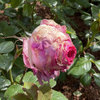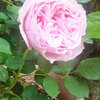How to stop Black Spot?
All my rose bushes started forming black spots. I've read on a bunch of forums that an organic remedy of milk and water will do the trick. How effective is that? How often should I be spraying and about how long does it take to work? Alos, should i pouring this mixture into the soil or just spray it onto the leaves?
This post was edited by ms642 on Sat, May 25, 13 at 13:59
Comments (100)
meredith_e Z7b, Piedmont of NC, 1000' elevation
10 years agolast modified: 9 years agoOn that note from Kim, I can say that Kordes roses just love it here. Shrub roses in general do really well for me that way, but Kordes are absolutely bulletproof in my garden.
Kippy
10 years agolast modified: 9 years agoI don't have anything to add on black spot but I thought I would mention this.
A few years back I heard a long time gardener speaking and he noted that in all of his years living in this town and all the various weather patterns, every year is unique.
We have had some really bad peach leaf curl going on, I have the sprayer, the spray and planned on spraying. But ran out of time. Nothing got sprayed.
Odd thing, we have no peach leaf curl. At least none on any of the trees I have checked. Go figure....what was different. Half the rain and skipped the fog this year. Now I did do some hard core pruning and thinning in the past years, so that might have had an effect.
Next year we might have rampant leaf curl (I still plan on spraying)
So this year if something that has always been clean or bad, remember that before you decide it was one garden technique or another that caused/cured it, maybe what is more important is if you can replicate the same result year after year. If not, it might be mother nature playing with you, just like my peach leaf curl.
Related Professionals
Ashburn Landscape Architects & Landscape Designers · Fort Lee Landscape Architects & Landscape Designers · Rancho Palos Verdes Landscape Architects & Landscape Designers · Winder Landscape Architects & Landscape Designers · Brandon Landscape Contractors · Columbine Landscape Contractors · East Hanover Landscape Contractors · Forest Hills Landscape Contractors · Fort Myers Landscape Contractors · Middle River Landscape Contractors · National City Landscape Contractors · San Bruno Landscape Contractors · St. Louis Landscape Contractors · Twin Falls Landscape Contractors · Wilsonville Landscape Contractorsroseseek
10 years agolast modified: 9 years agoAbsolutely, Kippy. That is right in line with my earlier comment that trials give bushes two years, three for climbers, before passing judgements. Each year is different, but there are usually patterns you'll see over time. If more recent Kordes roses are performing well for Meredith, that should be noted and taken into consideration for others in her state and zone. They may have the resistance to the strains of black spot existing where she is that's needed. Thank you for jumping right on the idea! We CAN make a useful database. Kim
henry_kuska
10 years agolast modified: 9 years agoThe following was stated: "We do not "promote" it--we simply tell those posters the truth--that the Bayer fungicide is effective in our garden and many, many posters on GW over the years agree with us that it is very effective. If I did not know how often and how many posters have posted on this forum that the Bayer fungicide works for them, I would not recommend it to posters asking for an effective fungicide."
H.Kuska comment. It is my impression that there are a small number of posters (and mainly the same ones) who repeatly post that the Bayer fungicide works for them. I try to save the blackspot posts and in a quick look through I feel that there were not threads that support the statement: "many, many posters on GW over the years agree with us that it is very effective".
Perhaps someone can give the link to at least one thread that supports the "many, many" statement.
----------------------------------------
Also no one has pointed to a controlled scientific study comparing tebuconazole to other available fungicides that supports that concept ("very effective"), and the supporters just ignore scientific evidence when the conclusion says that in that study: "Tebuconazole did not control blackspot.".
Another point that the apparently "only tebuconazole" advocates in this forum do not address is that they do not recommend rotation of fungicides to prevent the blackspot from developing a resistance to it. Many of the blackspot articles that I read recommend rotation. (I suggest a Google search with the three key words: roses blackspot rotation).
Example:
"3.Chemical: Chemicals such as chlorothalonil (Daconil), myclobutinol (Immunox), tebuconazole (All-in-One Rose and Flower Care), and neem oil (Fungicide 3) may be used to control black spot. Most of these should be sprayed at a 7 to 10 day interval. For best control, rotate two or more chemicals to prevent the fungus from building up a resistance to one chemical. Spraying should start as soon as leaves appear in the spring and continue into the fall until frost."
httphttp://johnston.ces.ncsu.edu/gjuly09/
----------------------------------------Here is a link that might be useful: North Carolina extension and rotation quote
mori1
10 years agolast modified: 9 years agoKordes roses, the 4 roses I got from eurodesert roses and JFK are the ones that the healthiest in my garden. They seem to get the least amount of BS in my garden. And I'm kind of wondering if the adding of the liquid seaweed with the fungicide is helping the roses do a better job of fighting the BS. Because the foliage looks really good, well at least the ones that the rose slugs have destroyed.
maemploi
10 years agolast modified: 9 years agoOnce you have discovered that your rose bushes are infected it is best to prune off the damaged parts of the plant and gather the diseased foliage
Here is a link that might be useful: Maroc Emploi
buford
10 years agolast modified: 9 years agoI don't rotate because I don't find it necessary. I know some people that do, but they might be more fussy about their roses and some are exhibitors, which is a whole different world.
I say the Bayer spray works because it does. And Daconil works, but you need to spray it every week. I'd rather use the Bayer and spread out my spraying to two or more weeks. That lessens my exposure and the amount of chemicals in the yard.
As for 'small number' of posters who say the Bayer works, well I'd say there is only one poster who has said Bayer doesn't work.
Again, I don't care what anyone else does with their roses. But if people ask for advice I will share my experiences. And if I see something posted that does not seem right, I will also speak up.
I would not spend $30 a year and make a special trip to Lowes just to get the Bayer spray concentrate, have a backpack sprayer and fill it up every 2-3 weeks and carry it around (it weighs about 40 lbs filled) my yard and spray my roses if it didn't work. I don't need a scientific paper to tell me if it works or not, I can see the results for myself.
henry_kuska
10 years agolast modified: 9 years agoThe following was stated: "I don't rotate because I don't find it necessary. I know some people that do, but they might be more fussy about their roses and some are exhibitors, which is a whole different world. "
H.Kuska comment. the above sounds like the spraying only with tebuconazole is effective unless one is "more fussy". i.e. effective is a relative term.
The following thread discusses rotating fungicides.
Here is a link that might be useful: link for above
henry_kuska
10 years agolast modified: 9 years agoKim stated the following: "Until we have the database to list which rose varieties are resistant to which of the FIVE strains of black spot fungi in the US and where each strain exists, I think the best advice we could use would be to report which roses resist spotting in each poster's location. Create a preliminary database of what remains clean where, then use that information to select the healthiest plants for each area. "
The link below is one attempt to create such a database.
Kim's point and not rotating fungicides merge because practically, by not rotating tebuconazole , one is contributing to the creation of a new strain of blackspot - one that is resistant to tebuconazole."Seven isolates of Marssonina rosae (imperfect stage of Diplocarpon rosae) elicited different blackspot disease expression among 39 Old Garden Roses In laboratory tests. 'Felicite Parmentier' (Alba), 'Mme. Hardy' (Damask), 'The Bishop' (Centifolia) and 'Rosa Mundl' (Gallica) showed no symptoms. 'Cardinal de Richelieu' (Gallica), 'Hermosa' (China) and 'Leda' (Damask) were the most. susceptible showing a culuvar ratings ", mean of 2.86 or more. The Wayne variant was the least virulent, causing susceptible reactions on only 46.1 % of the roses. The Hinds varIant was the most virulent and caused symptoms of 89.7% of the rose plants tested. The remaining five variants caused disease on 69.1% to 79.5% of the plants."
Here is a link that might be useful: Mississippi scientific paper concerning strains of blackspot
henry_kuska
10 years agolast modified: 9 years agoThe following was stated: "Henry asked for a link showing the superiority of Bayer Disease Control (tebuconazole) to other synthetic fungicides"
H.Kuska comment: The thesis and the resultant published reviewed scientific paper only compared strobilurins and triazoles. Since the paper came after the thesis and was subject to scientific scrutiny by the journal editor and reviewers, I will concentrate on the paper.Title: "Efficacy of triazoles and strobilurins in controlling black spot disease of roses caused by Diplocarpon rosae"
Authors: E.W. Gachomo1,2, H.-W. Dehne1 & U. Steiner
Published in: Annals of Applied Biology, volume 154, pages 259-267, (2009).
E.W."Abstract
Black spot disease is an important disease of roses with worldwide occurrence. It is caused by Diplocarpon rosae, an ascomycetous fungus and its control relies on fungicides. The effects of strobilurins and triazoles on D. rosae development within the host and on disease symptoms have not been well studied. Strobilurins completely inhibited germination of conidia when applied protectively 1 week before inoculation or on the same day with the inoculum. They were, however, not effective in eradicating the disease when applied after the fungus was established in the host. Triazoles reduced the germination rate of the conidia when applied protectively and they inhibited disease symptom development when applied after the fungus was established in the host but before symptom expression. Application of triazoles after symptom development suppressed further development of the disease, but in the case of treatment with myclobutanil yellowing and defoliation still occurred. Post-infection application of triazoles led to the apparent breakdown of subcuticular mycelia, intercellular mycelia, and hyphae in the epidermal cells, while the effects of strobilurins were limited to the subcuticular mycelia. Triazoles were more effective than strobilurins because they are more systemic."From the Discussion Section.
"Our results show that the two groups of fungicides are
effective at different stages of the fungus development and
can therefore be incorporated into a disease management
programme. The strobilurins are suited for pre-infection
applications, while the triazoles are suited for postinfection
applications. As application of myclobutanil after symptom development did not hinder the yellowing and subsequent defoliation of the diseased leaves, it can be used in pre-infection treatments but before the appearance of symptoms, while tebuconazole can be used even after symptoms have become visible. The development of
the fungus within the host is influenced by the prevailing
weather conditions (Gachomo & Kotchoni, 2007).
Therefore weather conditions that delay the development
of the fungus may allow for the prolonged use of
certain fungicides. The fact that different rose cultivars
have differing degrees of resistance (Knight & Wheeler, 1978; Castledine et al., 1981; Walker et al., 1995; Wiggers
et al., 1997; Drewes-Alvarez, 2003; Blechert & Debener,
2005) should be taken into account, thereby giving the
growers a very flexible disease management plan depending on the cultivars that they grow."In the body of the article: "Table 1 Effects of different fungicides on the development of Diplocarpon rosae and black spot disease on rose leaves, when applied 3 and 10 dpi and observed 10 and 14 dpi, respectively" There is a + in the "Symptom Development" column for tebuconazole.
(dpi means that the plants were treated with the fungicide 3, 7 or 10 days after (post) inoculation)."Black spots with a diameter >10 mm developed on
untreated plants. The infected leaves turned yellow but
the leaf tissue around the black spots remained green
forming ‘green islands’. Infected leaves dropped off the
plants beginning 15 dpi. There were differences in the efficacies of fungicides when they were applied curatively.
The symptoms observed were classified according to the
disease scale given under materials and methods, and results summarised in Fig. 4.
Post-inoculation application of both triazoles 3 dpi, and
of tebuconazole 7 dpi inhibited disease expression, while
post-inoculation applications of trifloxystrobin and pyraclostrobin led to varying degrees of disease severity. The effects of the four fungicides on disease symptom development at different times before and after inoculation and the corresponding fungal developmental stages in the
untreated plants are summarised in Fig. 4."
---------------------------------------------------------
H.Kuska comment. Unfortunately, the disease scale results are not given in Figure 4. One can estimate the disease severity for tebuconazole when the fungicide is applied at 10 days after disease introduction as 3 to 7 % from the small graph in Figure 4. No data were presented for longer time periods but the slope is positive.
-----------------------------------------------------------
Regarding the Hagan study being "an anomalous result". According to Google Scholar that paper was cited by 11 more recent papers. I looked at them and I did not see any that were challenging the results. In fact the Hagan group cited it in March 2011. (J. Environ. Hort. 29(1):25��"28. March 2011). ""Previously, foliar applications of tebuconazole have been shown to control Entomosporium leaf spot on photinia (2) but not black spot on rose (9)."H.Kuska comment: Please notice the editor and reviewers allowed that statement to be published in 2011.
In the Gachomo paper the Hagan study was not challenged (not even mentioned). In the thesis the Hagan paper was mentioned but not discussed to my satisfaction. "In previous studies Hagan et al (1991) had shown that weekly sprays of tebuconazole at the rates of 20, 40 and 80 ppm gave only some modest reductions in the disease and that the weekly applications of the fungicide at all these rates were equally effective in controlling the blackspot disease. Although the application of tebuconazole at the above mentioned rates gave a season long reduction is disease ratings compared to the untreated control, heavy leaf spotting and some leaf shed was observed on plants treated annually with this fungicide (Hagan et al 1991)."
Please notice that Hagan group used a lower dose rate then the Gachomo group. What dose rate did you use?Yes a reference to Peterson's 1989 paper was mentioned by the Hagan group. They explained the difference as "probably" being due to a difference in the disease pressure. How did you rule out your personel findings also being different due to the difference in disease pressure?
Here is a link that might be useful: Efficacy of triazoles and strobilurins in controlling black spot disease of roses caused by Diplocarpon rosae
dublinbay z6 (KS)
10 years agolast modified: 9 years agoHenry, do you like to argue just for the sake of arguing? If long-time posters on this forum say they use Bayer fungicide and it works better than all the other fungicides they had tried in the past, do you think they are lying? Just making up stories for the fun of it? What? Why would someone lie about such a thing?
Whether you and your papers like it or not, I have been using Bayer fungicide for 4-5 years now--BECAUSE IT WORKS. I don't need a paper to tell me if it works. I look at my roses which stop having BS problems after I spray them. That is my test.
Would other fungicides also work? Possibly. The ones I have tried in the past didn't work very well. Are there fungicides I haven't tried? Yes. But I don't recommend fungicides (or other products) that I do not have personal experience with.
I learned about Bayer fungicide years ago from a rose grower in Florida named Pete. I'm glad he introduced me to Bayer fungicide--though I still maintain adamantly that buying roses that are very disease-resistant is the best line of defense. I have roses in my garden that almost never get sprayed because they almost never get BS.
If it works in my garden, why should I change to a different product?
Kate, the pragmatist rather than the theoretician
henry_kuska
10 years agolast modified: 9 years agodublinbay, not everyone has the same disease pressure as you do. What works in your garden may not work in a higher disease pressure area. Please go back and read my comments:
"Posted by henry_kuska z5 OH (kuska@neo.rr.com) on Tue, May 28, 13 at 17:33buford your personal experience is with your variety of roses in your soil conditions exposed to your climate conditions with the strains of blackspot that are in your garden.
I recommend that one not attempt to extrapolate to other conditions."
-------------------------------
I am a scientist attempting to explain what scientists have determined about the ability of fungicides to control blackspot using controlled scientific methods. Scientists have determined other properties of tebuconazole that you may want to consider in deciding whether to continue using it. One example is its ability to "stunt" your roses. " With elevated drench rates of tebuconazole on roses, however, deep green leaf color, noticeable chlorosis around the leaf margin, reduced leaf area, and shortening of the shoot internodes was occasionally noted (Hagan, personal
observation)."Here is a link that might be useful: link for stunting quote
dublinbay z6 (KS)
10 years agolast modified: 9 years agoOf course it works in my garden. That is what I said.
Of course it works in Buford's garden. That is what Buford said.
A poster asked if we could recommend an effective fungicide. Buford and I recommended that fungicide that works effectively in our gardens.
So why do you keep on arguing about it? It works in our gardens--of course we would recommend what works in our gardens. I never recommend something that does not work for me. Are you saying you recommend products that do NOT work for you? Of course not. We recommend what works in our gardens. Of course. Of course. Of course. (How many times does that have to be pointed out to you before you hear it?)
And I might add, my roses sprayed with Bayer fungicide have NEVER exhibited "stunting," "chlorosis around the leaf margin," "reduced leaf area," NOR "shortening of the shoot internodes." I don't know what in the world your scientists are doing with the fungicide to produce those results, but if they occurred when I used Bayer fungicide, I would QUIT using Bayer fungicide--since that would not meet my criteria for an "effective" fungicide.
But I have NEVER had those results from using Bayer fungicide in my garden. It has always EFFECTIVELY stopped the BS infection with NO such negative consequences.
Now tell me I am lying. Is that what you really believe? How insulting can you be!
(NOTE: This is a disgusting thread because of your quarrelsomeness, and I am leaving it. Go find someone else to go quarrel with.)
Goodbye.
Kate
dublinbay z6 (KS)
10 years agolast modified: 9 years agoDuplicate post deleted.
Kate
This post was edited by dublinbay on Thu, May 30, 13 at 10:18
User
10 years agolast modified: 9 years ago"Henry, do you like to argue just for the sake of arguing?"
Kate, darlin' - you put your finger right on it.
buford
10 years agolast modified: 9 years agoKate, great post.
I'm not sure what Henry's point is. I though he hated all chemicals and didn't want anyone to spray anything. But it sounds like he's trying to get us all to spray more and different chemicals. I can't keep track.
I have to go now and report back to the President of Bayer as to my efforts in promoting their products :)
henry_kuska
10 years agolast modified: 9 years agoThe following was stated: " dublinbay z6 KS (My Page) on Tue, May 28, 13 at 21:06
My experience with Bayer Advanced Disease Control is the same as buford's and diane's--except that my region doesn't have as much BS pressure as their region does, so I can get by spraying considerably less than they do.
I usually wait until I actually see some blackspot--then I spray once and, if needed, about 10 days later again. That usually takes care of it in the spring. Summers here are too hot for BS, so I don't worry much about it until fall when the temps drop into the BS range again--in which case I may need to spray a time or two again..I agree with Buford. Anyone who uses Bayer Advanced Disease Control and still has BS and defoliation is doing something wrong. It is very effective and it does not kill bees and butterflies in my garden.
H.Kuska comment: please notice the "Anyone who uses Bayer Advanced Disease Control and still has BS and defoliation is doing something wrong."
henry_kuska
10 years agolast modified: 9 years agoRegarding the known stunting problem of tubuconazole.
Here is a link that might be useful: link for above
michaelg
10 years agolast modified: 9 years agoAll,
Henry's arguing can be annoying, but IMO it is constructive. He thinks clearly and of course is extremely well informed.
Henry,
Regarding spray concentration: I don't understand the units you cited. If you care to make the conversion, I use the labeled concentration of Bayer, which is 0.75 fl oz to a gallon. The product is 3% tebuconazole.
Regarding stunting: I observed stunting of shoots in a mini-trial of propiconazole (Bonide version of Banner) applied to one side of a Marie Pavie plant. I have not noticed any stunting with Bayer tebuconazole. My roses grow quite vigorously. Stunting was observed with "elevated drench levels," not with spraying per directions.
Regarding disease pressure in my garden, based on comparing reports of blackspot resistance and effects of non-synthetic sprays from various parts, blackspot pressure is worst here in Appalachia and in the mid-Atlantic states. Olga in Maryland and Diane in NJ have reports similar to mine (very few repeating roses are resistant).
buford
10 years agolast modified: 9 years agoIf he was just arguing, or discussing, it would be fine. But he has an accusatory tone which I don't care for.
Now, Henry, you want to cite my comment that if the Bayer doesn't work, you are doing something wrong. I stand by that. Strawberry Hill said that she used Bayer spray and her roses were 'naked with black spot'.
Now you are trying to link my comment to a stunting problem. Apples and Oranges. Like michael, I've never experienced that.
There are many things you can do incorrectly to not have the Bayer work properly. You could not have the correct mixture (too little and it would be ineffective, too strong, could damage the roses), you could spray when it's too hot, or too cold, or too wet, or too windy. All of these could change how the spray works.
But if you do it correctly, it works. And it works quite well. Otherwise michael, kate, myself and many others (there are rose growers that exist outside of GW), wouldn't use the product, we'd find something else.
harryshoe zone6 eastern Pennsylvania
10 years agolast modified: 9 years agoI will add myself to the list of folks in the "high pressure" areas who report that Bayer fungicide keeps my highly-susceptible HT's clean and works better than any of the other products I have tried. I rotate with Fungonil.
In my garden, every rose gets some black spot. That includes my OGR's, KO and The Mayflower.
Below are 3 HT's which were last sprayed the first week of May. Not one spot!
henry_kuska
10 years agolast modified: 9 years agoThe following was stated: "Now you are trying to link my comment to a stunting problem. Apples and Oranges."
H.Kuska comment. Your comment was not linked to a stunting problem. It pointed out what you said ("using quotes"). You did not say you MAY have done something wrong IF your blackspot conditions were the SAME as mine, and your rose varieties were the SAME varieties as mine, etc.
buford
10 years agolast modified: 9 years agoYes, I stand by that statement. It works. I've also laid out all the variables to what can go wrong when you are spraying that can make it less effective.
As my computer trainer DH says 'the odds that a computer makes a mistake are vastly dwarfed by the odds that it's operator error'.
I'm not sure what you have against Bayer or why you keep harping on first it's danger to the environment and now to it doesn't work and will harm plants. Don't use it. And trust me, if it really doesn't work, no one will use it.
henry_kuska
10 years agolast modified: 9 years agoThank you harryshoe for your input. Please note that he stated: "I rotate with Fungonil."
The active ingredient in Fungonil is Chlorothalonil. The 1991 Hagan group paper found Chlorothalonil to be: (H.Kuska note: for some reason, the cut and paste will not work with this paper so please read the paper and fill in this section.)
Because of the possibility of tebuconazole to cause tebuconazole resistant blackspot, I strongly recommend the rotation with a fungicide with a different mode of action.
No one has mentioned that the Bayer tebuconazole label only allows three sprayings per year when blackspot is present. I assume this is because of the above possibility.
Here is a link that might be useful: link to Hagan group research paper.
henry_kuska
10 years agolast modified: 9 years agoThe following was stated: "And trust me, if it really doesn't work, no one will use it."
H.Kuska comment. One does not divide the world into black and white only type thinking. No one has said that tubuconazole never works under any conditions. The Hagan group paper made that clear with the quote that I presented earlier concerning a prior paper that reported that it worked. Even the German paper found blackspot in the "One can estimate the disease severity for tebuconazole when the fungicide is applied at 10 days after disease introduction as 3 to 7 % from the small graph in Figure 4. No data were presented for longer time periods but the slope is positive. " at the higher concentration of tebuconazole that they used
seil zone 6b MI
10 years agolast modified: 9 years agoI think that Henry's point was that if you ARE going to use chemical intervention than it's prudent to rotate active ingredients. I don't think he was promoting the use of chemicals per se, just that you need to rotate them if you do so that you don't build a more resistant strain of what ever it is you're going after. I think that one has been well documented in a lot of cases across the chemical world, even in medicine.
I hate using chemicals so for the most part I never touch them. BUT I have broken down and did the deed when things were way out of control. When I do so I do rotate what I use so as not to saddle myself with a type of black spot that nothing will work on. That's just biting off your nose to spite your face.
dublinbay z6 (KS)
10 years agolast modified: 9 years agoHenry, I don't know what Bayer product you are looking at, but I assure you that my Bayer fungicide says absolutely nothing about only 3 sprayings per year.
And after 4 (or more) years of spraying with only Bayer fungicide, I find that the blackspot has NOT become resistant to Bayer fungicide.
I really am beginning to think you are talking about a different Bayer product than the rest of us are. Are you perhaps referring to the Bayer 3-in-1 product ? Or maybe the Bayer 2-in-1 product? Or maybe some other Bayer product? If so, they are NOT what we are talking about when we refer to Bayer Advanced Disease Control for Roses, Flowers, and Shrubs--which is what we use.
You can make all the assertions you wish, based on a paper study. They will still be WRONG, based on the actual roses growing in our gardens.
Kate
dublinbay z6 (KS)
10 years agolast modified: 9 years agoDuplicate posting deleted. I guess my computer is getting as aggravated as I am about this stupid argument.
This post was edited by dublinbay on Thu, May 30, 13 at 15:17
michaelg
10 years agolast modified: 9 years agoHenry said, "the Bayer tebuconazole label only allows three sprayings per year when blackspot is present." I think he is misinterpreting. For general preventative treatment of rose diseases it says "every 7-14 days." For certain other preventative uses it says "at least 3 times per year." Under "to treat existing disease" it specifies 3 applications. I think that means 3 applications will clear up an outbreak, not that only 3 are allowed.
The label does not recommend rotating with another fungicide, which many other fungicide labels do recommend. This suggests that Bayer is not worried about home garden use of tebuconazole leading to resistant fungi and consequent loss of that market. However, it is of the type to which resistance could develop.
This post was edited by michaelg on Thu, May 30, 13 at 15:34
henry_kuska
10 years agolast modified: 9 years agoRegarding label, see link below.
Here is a link that might be useful: Link for label
dublinbay z6 (KS)
10 years agolast modified: 9 years agoNo one has mentioned that the Bayer tebuconazole label only allows three sprayings per year when blackspot is present, claims Henry.
Shame on you, Henry. That is not what the label says. You have twisted Bayer's words to make them supposedly back your misapplied argument.
What Bayer says is that 3 sprayings may be needed to wipe out the current infection (I always have found that 2 sprayings are sufficient.) Bayer is NOT warning consumers to limit spraying to 3 times a year. That is WRONG, WRONG, WRONG. It is simply claiming that it won't take more than 3 sprayings to get rid of the infection you have today.
Now if you don't spray after those 3 sprayings, the rose could later get re-infected. In which case, it should not take more than 3 sprayings to wipe out that later infection. (In my garden, 1 or 2 sprayings are all that is needed to wipe out an infection outbreak.)
I'm serious, Henry. A "scientist" who misreads that badly can not really be trusted. I'm also very concerned that you are giving out this mis-information to newbies who have no basis for deciding yet which view is more trustworthy.
Just give it up, Henry. You are just digging the hole you are in deeper and deeper.
And if you had not insisted on dragging this out so needlessly and scornfully, I would not have directly impugned your scientific integrity--but really, this has become outrageous and needs to stop.
Kate
dublinbay z6 (KS)
10 years agolast modified: 9 years agoAnother duplicate post deleted. Geesh!
KateThis post was edited by dublinbay on Thu, May 30, 13 at 15:50
henry_kuska
10 years agolast modified: 9 years agoPerhaps looking at the label for a different company will clarify.
"Do not apply more than 6 applications per year in all states except New York, and do not apply more than 3 applications per year in New York State."
Here is a link that might be useful: link for label
henry_kuska
10 years agolast modified: 9 years agoRegarding the ability of tebuconazole to cause stunting.
Whenever I visit California, I come back feeling that all of my roses are stunted.
I make this statement because some people have claimed that tebuconazole does not cause stunting of their roses. My question is how do they know? Do they grow the same rose side by side with one not sprayed with tebuconazole?
One's tebuconazole sprayed rose may not be stunted, it may be stunted 1 %, 5 %, etc.
Stunting is a known property of tebuconazole. This is scientific fact. Unless you are interested in Queen of Show it may not be of importance when you set up your spray program, but it may be of interest to someone else with different goals and blackspot intensity.
michaelg
10 years agolast modified: 9 years agoThe other tebuconazole label is for a product to be used on golf courses, nurseries, and field-grown ornamentals. Resistance is much more likely to develop and spread in large-scale applications than home gardens. Therefore this label contains a warning about resistance and limits on the number of applications per year (6). The home garden label does not.
dublinbay z6 (KS)
10 years agolast modified: 9 years ago"Do not apply more than 6 applications per year in all states except New York, and do not apply more than 3 applications per year in New York State," quotes Henry.
Again, poor reading skills. That direction is for professionals using professional strengths to spray grass--like the putting green at your golf course. Or for when you take out your airplane and spray your ACRES of plants out there in the fields--as in professional agri-business (farmers).
It has nothing to do with amateur home garden use, following the directions on the home garden product to spray a couple dozen roses.
And compared to California roses, everybody's roses look somewhat stunted, whether we spray or not. All that proves is that roses grow good in California--but we have all known that for a long time now.
You just can't let go, can you.
Kate
buford
10 years agolast modified: 9 years agoI assure you my Teasing Georgia with 20 foot canes is not stunted. And if it is, THANK GOD!!!!!
henry_kuska
10 years agolast modified: 9 years agoAnother label which mentions roses.
In the Ornamental Section the following appears: "Do not make more than 4 applications per year at highest rate."
Here is a link that might be useful: Another label which mentions roses
henry_kuska
10 years agolast modified: 9 years agoMy cut and paste does work on this one:
"Guidelines for Developing an Effective Fungicide Spray Program for Wine Grapes in Maryland, 2012"
"Strobilurin-resistant strains of powdery mildew are also losing sensitivity to sterol-inhibiting (SI) fungicides, particularly Rally and Elite (including generic formulations of tebuconazole). SI resistance occurs more slowly, and growers may able to compensate for a few seasons by increasing the application rate (up to the label rate), spraying at shorter intervals, or switching to a different SI. The more frequently any SI material is used, however, the higher the level of resistance that is likely to develop."
Here is a link that might be useful: Guidelines for Developing an Effective
dublinbay z6 (KS)
10 years agolast modified: 9 years agoOk--so switch back and forth in your garden if you want to. Nobody is stopping you.
But you are still confusing professional strengths used at professional rates and in professional quantities with limited amateur home garden use.
Kate
henry_kuska
10 years agolast modified: 9 years agoMichael I was planning on doing the concentration conversions this afternoon, but as you see other posts received my attention. The Hagan group use 0.04 gm. 0.08, and 0.16 per liter (which can be thought of as per 1000 gm.
Bayer recommends 1.5 tablespoons of the concentrate added to 256 tablespoons of water (1 gallon). 2.9 % concentrate is 2.9 gm tebuconazole per 100 grams of solution. 1.5 tablespoons of the concentrate were added to 256 tablespoons of water (1 gallon). This is a dilution factor of about .0058. So now one has about 0.18 grams in 1000 gms of solution. I made several approximations in the calculation. I feel that we can say that the Hagan group top concentration is probably within round off error of the Bayer recommended concentration.
We do not have to make the conversion from grams per liter to ppm as the Gachomo Thesis has done it for us ("In previous studies Hagan et al (1991) had shown that weekly sprays of tebuconazole at the rates of 20, 40 and 80 ppm ....." ) , we see that the Gachomo group (by using a concentration of 100ppm) used a concentration 1,25 higher than the Hagan group.
henry_kuska
10 years agolast modified: 9 years agoThe following was stated: "But you are still confusing professional strengths used at professional rates and in professional quantities with limited amateur home garden use. "
H.Kuska comment. I am interested in the amount sprayed per rose due to concerns about both stunting of that rose and blackspot mutation on that rose .
Perhaps reviewing the thread that I linked to earler will be useful in seeing that blackspot mutation could be a real concern.
"What you're doing by spraying more frequently is allowing resistant spores to increase more frequently with no competition from non-resitant spores. The spores are living organisms - they will attempt to mutate, to evolve, and to produce more resistant strains if they are only exposed to one threat. If this threat is introduced more frequently, then that resistance will occur much faster and with greater magnitude."
Here is a link that might be useful: linked to earlier thread
Kippy
10 years agolast modified: 9 years agoI need a Bayer after reading this....where is my aspirin?
muffienh
9 years agolast modified: 9 years agoI used milk on peonies with powdery mildew. One treatment several years ago, and I have not seen any more since. I cleaned out all the old leaves of course. Guess I'll give it a go on black spot.
User
9 years agolast modified: 9 years agoThe original post of this I think the problem was in the mulch that was used caused his fungus problem and if it was raked off and tried using compost and a different mulch could get rid of the bs .
This post was edited by sam4949 on Sat, Aug 2, 14 at 15:49
ausblm
9 years agolast modified: 9 years agoHi im interested why there has been little mention of regular copper spray? Im amateur but find that its effective as part of my approach when used regularly especially spring summer. Pine or Eucalyptus mulch suppresses spores on the ground.
jjpeace (zone 5b Canada)
9 years agolast modified: 9 years agoWell, an acquaintance of mine who also works for a public garden up here had adviced me to use dormant oil in the spring. I will try it this upcoming spring to see if that works.
I was thinking that in the upcoming Spring, I may cut the bottom leaves off from each plant. I figure if there is no leaves at the bottom to get wet, it may reduce down BS. Well in theory anyways.




















michaelg